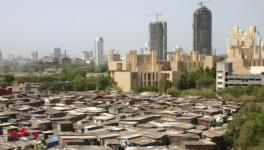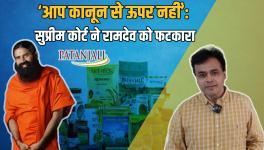Mahapadav Day One: Protest, Celebration the Key Themes as Workers Take Over the Capital

The sickly, grey fog enveloping the capital was torn apart by a river of colours this Thursday morning. It was day one of the workers’ Mahapadav—a three-day mega-protest on Parliament Street uniting trade unions from sectors as fundamental to the country as defence production, dockyards, healthcare, finance, construction, telecom as well as state and central government employees. Early on Thursday the mood was sombre. The city is in the throes of an environmental crisis with air pollution levels surpassing anything we have seen before. The response of the government, so far, to the 12-point agenda raised by the central trade unions made the situation all the more tense. The concerns are fundamental—all focused on the fact that at current wage and price levels it is impossible for workers to survive. With an overall membership of well over 10 million workers, these trade union federations represent the demands of a large chunk of working class India. But, over the past few years, their demands have fallen on deaf ears of the Modi govt.
After the massive march to parliament in December 2013, this is the largest workers’ gathering the capital has seen. Union members are pouring in from the Northeast to Maharashtra, Punjab to Kerala. There are men and women, retired and serving, contract and permanent, self-employed and government employees. And none of them were mincing words. Ashok Singh of the INTUC made the first speech of the day from the sizeable stage set up right in front of the Parliament Street police station. His accusation was that the government, with its policies of privatisation and foreign direct investment, is destroying the country. “Lekin hum India ko finish nahin hone denge, Modiji,” he said. “Hum aap ko khatam kar denge.” (We will not let your finish India, Mr Modi, we will finish your government). The crowd didn’t take too long to warm up to the rhetoric. “These (workers’) are the hands that have built India. We will not allow these hands to be cut off,” he concluded.
Gurudas Das Gupta, General Secretary of AITUC, dressed in faded blue jeans and a light cardigan, came next. He emphasised the need for workers to unite across party and political divides. “There are no politics and no colours here,” he said. “Today is not a question of flags or of politics. The question is of workers’ unity. Unity is our strength. We must fight the common enemy—the anti-worker and anti-people policies of this government. Fight to live and live to fight. That is our ideal. This Mahapadav is just the first battle. We must prepare, now, for the war.” In the crowd the sentiment resonated. Thousands of women, many of them anganwadi workers tasked with the implementation of various schemes such as midday meals and the provision of basic health and sanitation at community level, roared against the duality of the government’s words and actions.
“We are demanding to be paid in accordance with minimum wage legislation,” said an Anganwadi worker from Rajasthan. “Our sisters who are ASHA helpers don’t get paid anything at all. The officers sent on deputation to our departments put all kinds of pressure on us, especially when we unionise. On the one hand the government talks about women’s empowerment, but on the other they use their positions of power to further oppress us”.
“Hamesha bola jaata hai ki workers ke beech ekta nahi hai,” says Aruna, a volunteer with the Centre of Indian Trade Unions who has campaigned for and helped organise the protest. “It is not true. Yeh mahapadav ek mauka hai system ke saamne us ekta ko pesh karne ka. An industrial worker, for example, make 3000-4000 rupees after putting in a 12 hour shift. She cannot run a house with that, so has to work overtime. Workers simply do not have the luxury of time to demonstrate on a daily basis. But this mahapadav is evidence of the unity that exists among workers.”
As the mahapadav gathers momentum—hundreds of workers arrived through the day due to delays in train and bus timetables because of environmental conditions—it offers several opportunities. For union members it is a chance to meet and understand the concerns of fellow workers from other parts of India and working in different sectors. Workers from the Heavy Vehicles Factory in Avadi were conversing with anganwadi women from Haryana; Sikhs from Punjab took selfies with men in mundus from Kerala. Street vendors from the northeast ate a quick meal of chana and rice with Military Engineering Services employees from West Bengal. On the sidelines, and between speeches, people shopped for everything from cheap gold watches to shawls and Nehru jackets; children’s clothes and hammer and sickle keychains. As important as the points of protest is chance to be social and build shared experiences that transcend geography and local politics. For the Delhi media, and people at large too, it is a ready made opportunity to meet some of the men and women who are the backbone of the working class and to understand not just how fundamentally the system is stacked against this section of society. The atmosphere was electrified by the sharp rhetoric and harsh criticism of the government. Protest is the central theme, but so is celebration. Few can celebrate life with as much fervour as those who fight for everyday of it.
As Aruna puts it, “Some of our workers have brought rotis with ghee and pickle with them, enough for three or four days. Hamari yeh jo worker jaat hai na, surviving jaat hai. Kisi bhi condition mein survive kar sakte hain. This is our biggest strength”.
Get the latest reports & analysis with people's perspective on Protests, movements & deep analytical videos, discussions of the current affairs in your Telegram app. Subscribe to NewsClick's Telegram channel & get Real-Time updates on stories, as they get published on our website.
























